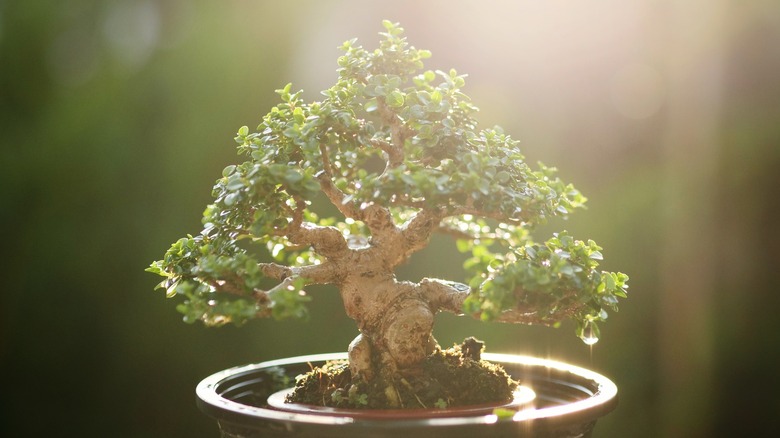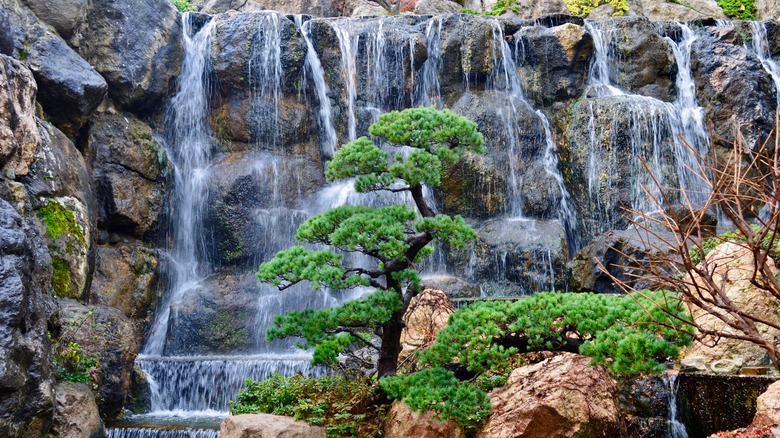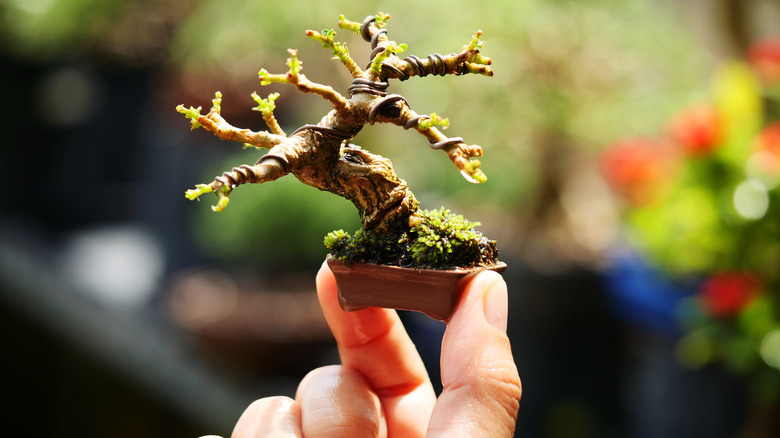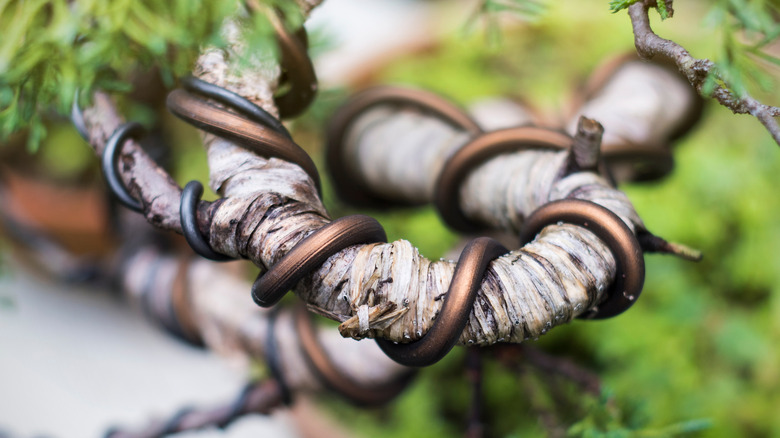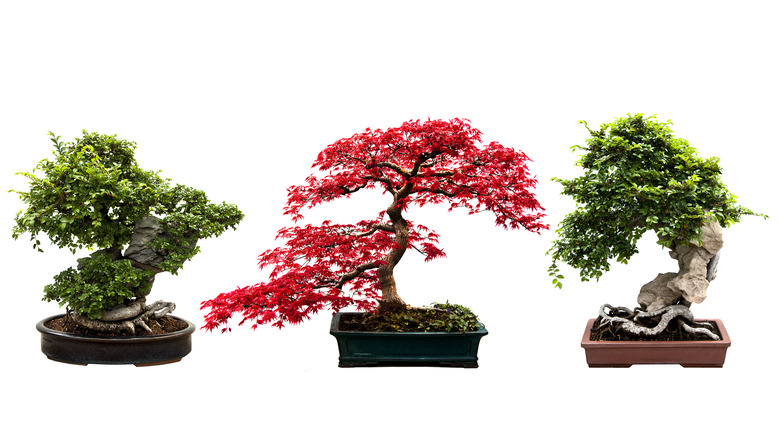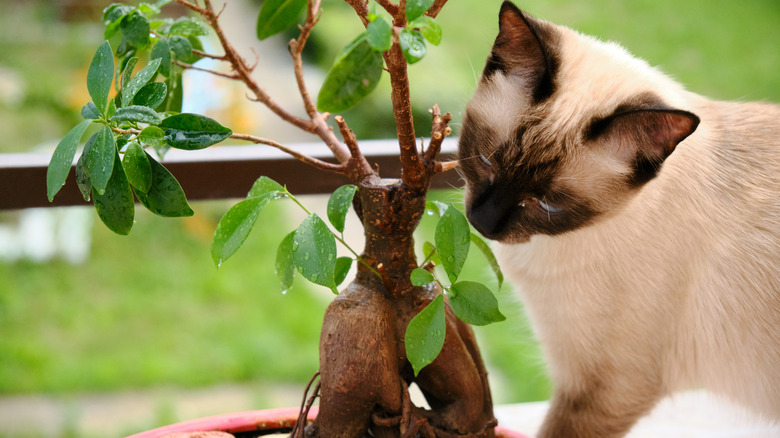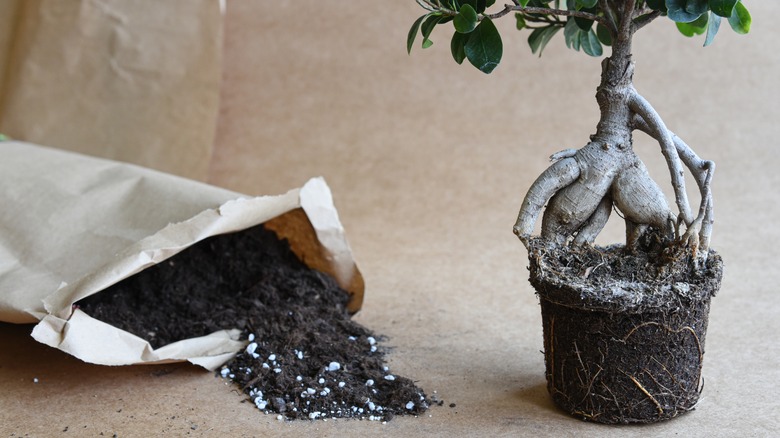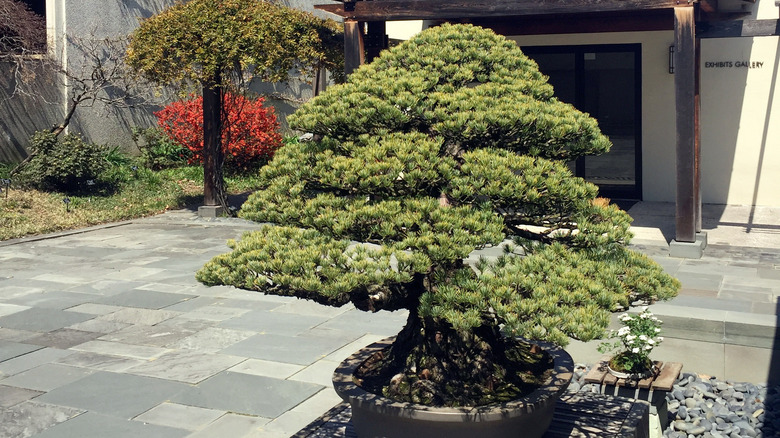How To Grow And Care For A Bonsai Tree
We may receive a commission on purchases made from links.
Pun-sai, the ancient art of pruning miniature landscapes, has been traced back to China and the year 700 A.D. However, it wasn't until almost 1200 B.C., during the Kamakura period, that the Japanese embraced this art form and explicitly focused on tiny potted trees rather than the broader landscapes, Bonsai Empire notes. The Japanese continued to hone this practice for centuries, and it wasn't until the 1800s that they changed its name to bonsai. Today the common word bonsai translates to "a tree planted in a shallow container" and is used interchangeably for both the art form and the plant itself.
Per Bonsai Empire, bonsai was practiced by people at every level of society, from commoners to military generals. It was particularly popular among zen Buddhist monks who admired the diligence and prudence required to maintain these delicate trees. Plant shows with judging contests have been happening for hundreds of years. What started out as a way to incorporate religion into daily life quickly became a highly sought-after skill in the realm of art and design. Cultivating a bonsai tree is a perfect way to relax and destress at the end of a busy day. The love and care you deliver will be fed back to you in the form of beauty and tranquility. Healthy bonsai are regularly passed down through generations, and many trees have lived for hundreds of years.
How to use bonsai trees in the garden
Much like a dollhouse, a bonsai tree is a miniature version of a life-size tree. Because they are created through careful pruning, as opposed to genetic modification, you can produce a bonsai from any tree species. This offers almost unlimited options for style when planning to add one to your garden or landscape design. They are also quite portable since they're bound to containers and are kept to a maximum height of 4 feet, often considerably less. First, study the type of tree you have chosen to figure out the best environmental conditions for its sustained health, and then you'll be able to move it around within those parameters.
The beauty of the bonsai lies in the peace and tranquility it brings to its environment. Bonsai work beautifully with a zen garden and water features, adding a touch of quirk and color to otherwise neutral spaces. As per Bonsai Tree Gardener, try using these shrubs to decorate a meditation corner. Wherever you place your small tree, think of your bonsai as a delicate centerpiece meant to bring an overall sense of calm to the area.
How to grow a bonsai tree
Ron Finley's MasterClass on gardening lays out the most important steps to growing a bonsai. If you start a new tree from seed, you'll need to crank your patience meter up to 10 because you're unlikely to see leaves until your baby tree is at least three years old, maybe even five. An easier option, of course, is to purchase a young bonsai. Contact a nearby specialty store for the best information and guidance. You'll have many size options, although they will all be relatively small and fit easily on a tabletop. Some young bonsai are so tiny they can fit in the palm of your hand.
It's possible that your new bonsai will not have been carefully maintained while sitting in a shop, so the first thing you'll need to do is repot it in a container that is slightly bigger than the one it came in. Once it is settled in fresh soil, position your bonsai close to a window for maximum sun exposure. When the soil is dry, give your tree a thorough soaking all the way down through the root system. Then allow it to drain completely and dry out before watering again. Letting your plant dry helps prevent root rot.
How to care for a bonsai tree
So much of bonsai care lies in the pruning and shaping of each tree. Bonsai masters have many ways of maintaining size and shape, from pinching buds to pruning leaves and stems. Wiring branches is another useful technique described by Bonsai Empire as a way to bend a tree into your preferred shape. You can use either aluminum or copper wire for this, but aluminum is recommended for a beginner since it is easier to work with. Only once you have successfully wired the branches of your tree can you begin the manipulate and shape them. For thick branches, Bonsai Empire suggests wrapping them with moistened raffia before applying the wire to keep it from damaging the bark.
Properly training and caring for a bonsai is not for the faint of heart. It is an art form that requires years of close study, a trained eye, and a high degree of patience. But don't let that stop you from giving it a try. Many in-depth resources are available for when you decide you love this intricate and satisfying hobby.
Bonsai tree varieties
You can train any tree to grow as a bonsai, but most novice gardeners are likely to be trying this process inside their homes. Per MasterClass, there are a few types that do best indoors.
- Evergreen trees such as Schefflera and ficus stay green as old leaves fall away and new ones grow. Two other popular options here are the money tree and juniper.
- Deciduous trees are different from evergreen trees because their leaves all fall off once a year in autumn and don't grow back until spring. The top options in this category are the Japanese maple or the Chinese elm.
- Succulents are plants with thick, squishy leaves built to retain high water levels in arid climates. The jade plant makes a great bonsai, particularly the dwarf variety called Portulacaria afra.
- Flowering trees such as gardenias and snow roses can produce a gorgeous bonsai that will delight the visual senses while also perfuming the air.
Is the bonsai tree toxic?
Generally speaking, most bonsai trees should prove safe for pets or humans. However, it's important to practice normal safety precautions. Because bonsai can be created out of any tree species, some will carry a higher risk factor than others. Munching leaves and ingesting flowers is the most common way for a pet to experience poisoning from a plant. Placing your bonsai on a high shelf away from pets and children will go a long way towards keeping everyone safe.
The folks at Grow Your Bonsai have created a handy list of some common trees used for bonsai that could be potentially poisonous. Sago palm and jade top the list, followed closely by juniper and azalea. Symptoms of poisoning include gastrointestinal discomfort and vomiting. So anytime you think your dog or cat has eaten a part of a houseplant, watch them closely for signs of distress and contact your veterinarian when necessary.
How to repot your bonsai tree
Bonsai are unique in the world of plants, and you'll find that repotting them requires a different set of steps than what you're used to for most houseplants. Aside from aesthetics, the biological goal of bonsai is to create a dynamic root system that continues to feed and grow a healthy tree over a long period. The tree doesn't necessarily get bigger because it's constantly shaped and pruned, but the roots need to continually grow in order to keep it alive. Per the extremely detailed repotting guide from Kaizen Bonsai, soil condition is a significant factor in maintaining a healthy tree, making repotting necessary. Once you have a basic understanding of soil porosity and airflow, you'll be able to tell when it's the best time to change the soil and repot.
Root pruning is just as important as leaf and branch pruning. Cutting back any woody, lignified roots encourages new white feeder roots to grow and increase the tree's strength. Anyone trying to grow long hair will understand; it's a lot like getting a trim at the salon to encourage long-term length. All this said, there are bonsai trees that have been growing in the same pots for hundreds of years. One thing we know for sure is their caretakers have an immense understanding of what those plants require from the small amount of soil they live in and how to get it to them.
A 400-year-old bonsai tree that survived Hiroshima
The most famous bonsai in the world is the Yamaki Pine, a 400-year-old Japanese white pine that miraculously survived the bombing of Hiroshima. It was lovingly maintained by bonsai master Masaru Yamaki and his family for five generations before the catastrophe. In 1976 the tree was one of 53 bonsai donated by the Nippon Bonsai Association to fill the gardens at the newly created National Bonsai Foundation. Built within the U.S. National Arboretum in Washington, D.C., the NBF also houses trees from within the United States and a collection of Penjing trees from China and Hong Kong.
According to the National Bonsai Foundation, repotting the Yamaki Pine last occurred in 2015. Caretakers knew it was time when water started pooling at the soil's surface, running off the sides of the pot rather than sinking into the roots. What followed was a meticulous and intricate process of suspending the 200-pound tree and its pot in the air with straps before delicately cutting through the soil to release the root ball. A hydraulic lift was maneuvered into place to catch the falling pot. Then, the gardeners could carefully release the old soil while being extremely cautious not to harm the healthy roots. One of the gardeners on hand for the lengthy process, Michael James, likened the experience to a mix of art restoration and archeology.
